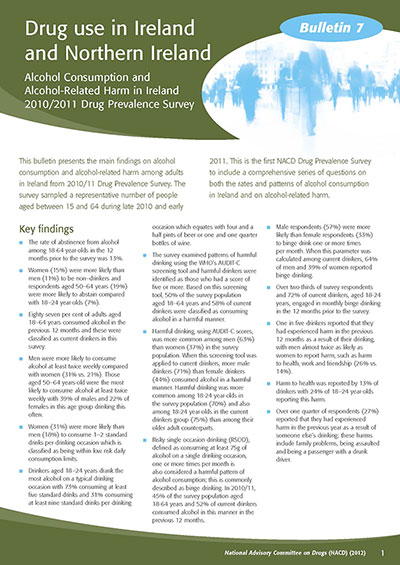Alcohol Consumption and Alcohol-Related Harm in Ireland 2010/2011
 A new report by the National Advisory Committee on Drugs (NACD) entitled: 'Drug use in Ireland and Northern Ireland: Alcohol Consumption and Alcohol-Related Harm in Ireland 2010/2011 Drug Prevalence Survey' was published yesterday.
A new report by the National Advisory Committee on Drugs (NACD) entitled: 'Drug use in Ireland and Northern Ireland: Alcohol Consumption and Alcohol-Related Harm in Ireland 2010/2011 Drug Prevalence Survey' was published yesterday.
Speaking at the launch in the Department of Health, Dublin, Minister Roisin Shortall said: “It is crucial that we as a society reduce the overall level of alcohol consumed in Ireland and also tackle the problems of alcohol misuse. I am determined that effective steps will be taken over the coming period to address problems associated with alcohol across our society."
Key findings from the report:
- The rate of abstinence from alcohol among 18-64 year-olds in the 12 months prior to the survey was 13%.
- Women (15%) were more likely than men (11%) to be non–drinkers and respondents aged 50–64 years (19%) were more likely to abstain compared with 18–24 year-olds (7%).
- Eighty seven per cent of adults aged 18–64 years consumed alcohol in the previous 12 months and these were classified as current drinkers in this survey.
- Men were more likely to consume alcohol at least twice weekly compared with women (31% vs. 21%). Those aged 50–64 years-old were the most likely to consume alcohol at least twice weekly with 39% of males and 22% of females in this age group drinking this often.
- Women (31%) were more likely than men (18%) to consume 1–2 standard drinks per drinking occasion which is classified as being within low risk daily consumption limits.
- Drinkers aged 18–24 years drank the most alcohol on a typical drinking occasion with 73% consuming at least five standard drinks and 31% consuming at least nine standard drinks per drinking occasion which equates with four and a half pints of beer or one and one quarter bottles of wine.
- The survey examined patterns of harmful drinking using the WHO’s AUDIT-C screening tool and harmful drinkers were identified as those who had a score of five or more. Based on this screening tool, 50% of the survey population aged 18–64 years and 58% of current drinkers were classified as consuming alcohol in a harmful manner.
- Harmful drinking, using AUDIT-C scores, was more common among men (63%) than women (37%) in the survey population. When this screening tool was applied to current drinkers, more male drinkers (71%) than female drinkers (44%) consumed alcohol in a harmful manner. Harmful drinking was more common among 18-24 year-olds in the survey population (70%) and also among 18-24 year-olds in the current drinkers group (75%) than among their older adult counterparts.
- Risky single occasion drinking (RSOD), defined as consuming at least 75g of alcohol on a single drinking occasion, one or more times per month is also considered a harmful pattern of alcohol consumption; this is commonly described as binge drinking. In 2010/11, 45% of the survey population aged 18-64 years and 52% of current drinkers consumed alcohol in this manner in the previous 12 months.
- Male respondents (57%) were more likely than female respondents (33%) to binge drink one or more times per month. When this parameter was calculated among current drinkers, 64% of men and 39% of women reported binge drinking.
- Over two-thirds of survey respondents and 72% of current drinkers, aged 18-24 years, engaged in monthly binge drinking in the 12 months prior to the survey.
- One in five drinkers reported that they had experienced harm in the previous 12 months as a result of their drinking, with men almost twice as likely as women to report harm, such as harm to health, work and friendship (26% vs. 14%).
- Harm to health was reported by 13% of drinkers with 24% of 18–24 year-olds reporting this harm.
- Over one quarter of respondents (27%) reported that they had experienced harm in the previous year as a result of someone else’s drinking; these harms include family problems, being assaulted and being a passenger with a drunk driver.
The NACD was established in response to the drug problem to assist in our continued need to improve our knowledge and understanding of problem drug use.













